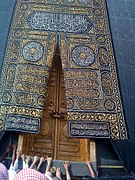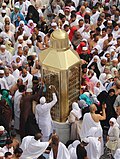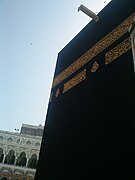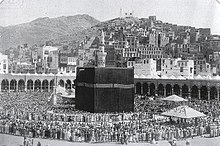Kaaba
| Kaaba (Ka'aba) | |
|---|---|
| ٱلْكَعْبَة | |

Pilgrims at the Great Mosque of Mecca
|
|
| Basic information | |
| Location | Mecca, Hejaz, Saudi Arabia |
| Geographic coordinates | 21°25′21.0″N 39°49′34.2″ECoordinates: 21°25′21.0″N 39°49′34.2″E |
| Affiliation | Islam |
| Country | Saudi Arabia |
| Height (max) | 13.1 m (43 ft) |
One of the Five Pillars of Islam requires every Muslim who is able to do so to perform the hajj pilgrimage at least once in their lifetime. Multiple parts of the hajj require pilgrims to make tawaf, the circumambulation seven times around the Kaaba in a counter-clockwise direction. Tawaf is also performed by pilgrims during the umrah (lesser pilgrimage).[2] However, the most significant times are during the hajj, when millions of pilgrims gather to circle the building within a 5-day period.[3][4] In 2013, the number of pilgrims coming from outside the Kingdom of Saudi Arabia to perform hajj was officially reported as 1,379,531.[5] In 2014, Saudi Arabia reported having completed Hajj permits for 1,389,053 international pilgrims and 63,375 for residents.[6]
Contents
Lexicology
|
This section needs expansion with: please specify where and by what names Kaaba is mentioned in Quran and Hadith. You can help by adding to it. (April 2016)
|
Architecture and interior
The Kaaba is a prismal stone structure made of granite. It is approximately 13.1 m (43 ft) high (some claim 12.03 m (39.5 ft)), with sides measuring 11.03 m (36.2 ft) by 12.86 m (42.2 ft).[8][9] Inside the Kaaba, the floor is made of marble and limestone. The interior walls, measuring 13 m (43 ft) by 9 m (30 ft), are clad with tiled, white marble halfway to the roof, with darker trimmings along the floor. The floor of the interior stands about 2.2 m (7.2 ft) above the ground area where tawaf is performed.The wall directly adjacent to the entrance of the Kaaba has six tablets inlaid with inscriptions, and there are several more tablets along the other walls. Along the top corners of the walls runs a green cloth embroidered with gold Qur'anic verses. Caretakers anoint the marble cladding with the same scented oil used to anoint the Black Stone outside. Three pillars (some erroneously report two) stand inside the Kaaba, with a small altar or table set between one and the other two. (It has been claimed that this table is used for the placement of perfumes or other items.) Lamp-like objects (possible lanterns or crucible censers) hang from the ceiling. The ceiling itself is of a darker colour, similar in hue to the lower trimming. A golden door—the bāb al-tawbah (also romanized as Baabut Taubah, and meaning "Door of Repentance")—on the right wall (right of the entrance) opens to an enclosed staircase that leads to a hatch, which itself opens to the roof. Both the roof and ceiling (collectively dual-layered) are made of stainless steel-capped teak wood.
A drawing of the Kaaba. See key in text.
A technical drawing of the Kaaba showing dimensions and elements
- Al-Ḥajaru al-Aswad, "the Black Stone", is located on the Kaaba's eastern corner. Its northern corner is known as the Ruknu l-ˤĪrāqī, "the Iraqi corner", its western as the Ruknu sh-Shāmī, "the Levantine corner", and its southern as Ruknu l-Yamanī, "the Yemeni corner" taught by Imam Ali.[2][9] The four corners of the Kaaba roughly point toward the four cardinal directions of the compass.[2] Its major (long) axis is aligned with the rising of the star Canopus toward which its southern wall is directed, while its minor axis (its east-west facades) roughly align with the sunrise of summer solstice and the sunset of winter solstice.[10][11]
- The entrance is a door set 2.13 m (7 ft) above the ground on the north-eastern wall of the Kaaba, which acts as the façade.[2] In 1979 the 300 kg gold doors made by chief artist Ahmad bin Ibrahim Badr, replaced the old silver doors made by his father, Ibrahim Badr in 1942.[12] There is a wooden staircase on wheels, usually stored in the mosque between the arch-shaped gate of Banū Shaybah and the Zamzam Well.
- Mīzāb al-Raḥmah, rainwater spout made of gold. Added in the rebuilding of 1627 after the previous year's rain caused three of the four walls to collapse.
- Gutter, added in 1627 to protect the foundation from groundwater.
- Hatīm (also romanized as hateem), a low wall originally part of the Kaaba. It is a semi-circular wall opposite, but not connected to, the north-west wall of the Kaaba. This is 90 cm (35 in) in height and 1.5 m (4.9 ft) in width, and is composed of white marble. At one time the space lying between the hatīm and the Kaaba belonged to the Kaaba itself, and for this reason it is not entered during the tawaf.
- Al-Multazam, the roughly 2 meter space along the wall between the Black Stone and the entry door. It is sometimes considered pious or desirable for a hajji to touch this area of the Kaaba, or perform dua here.
- The Station of Ibrahim (Maqam Ibrahim), a glass and metal enclosure with what is said to be an imprint of Abraham's feet. Ibrahim is said to have stood on this stone during the construction of the upper parts of the Kaaba, raising Ismail on his shoulders for the uppermost parts.[13]
- Corner of the Black Stone (East).
- Corner of Yemen (South-West). Pilgrims traditionally acknowledge a large vertical stone that forms this corner.
- Corner of Syria (North-West).
- Corner of Iraq (North-East). This inside corner, behind a curtain, contains the Babut Taubah, Door of Repentance, which leads to a staircase to the roof.
- Kiswah, the embroidered covering. Kiswa is a black silk and gold curtain which is replaced annually during the Hajj pilgrimage.[14][15] Two-thirds of the way up is a band of gold-embroidered Quranic text, including the Shahada, the Islamic declaration of faith.
- Marble stripe marking the beginning and end of each circumambulation.[16]
Religious significance
The Sacred Mosque and Kaaba during Hajj, 2008
Qibla
The Qibla is the direction faced during prayer.[Quran 2:143–144] It is the focal point for prayer. The direction faced during prayer is the direction of where the Kaaba is.Pilgrimage
The Sacred Mosque is the focal point of the Hajj and Umrah pilgrimages[19] that occur in the month of Dhu al-Hijjah in the Islamic calendar and at any time of the year, respectively. The Hajj pilgrimage is one of the Pillars of Islam, required of all able-bodied Muslims who can afford the trip. In recent times, about 1.8 million Muslims perform the Hajj every year.[20]Some of the rituals performed by pilgrims are symbolic of historical incidents. For example, the incident of Hagar's search for water is emulated by Muslims as they run between the two hills of Safa and Marwah whenever they visit Mecca.
The Hajj is associated with the life of the Islamic prophet Muhammad from the 7th century, but the ritual of pilgrimage to Mecca is considered by Muslims to stretch back thousands of years to the time of Prophet Ibrahim.
History
Islamic views on origin
The Quran contains several verses regarding the origin of the Kaaba, it states that the Kaaba was the first House of Worship, and that it was built by Ibrahim and Ishmael on God's[citation needed] instructions.Verily, the first House (of worship) appointed for mankind was that at Bakkah (Makkah), full of blessing, and a guidance for mankind.
Behold! We gave the site, to Ibrahim, of the (Sacred) House, (saying): "Associate not anything (in worship) with Me; and sanctify My House for those who compass it round, or stand up, or bow, or prostrate themselves (therein in prayer).
And remember Ibrahim and Ishmael raised the foundations of the House (With this prayer): "Our Lord! Accept (this service) from us: For Thou art the All-Hearing, the All-knowing.Ibn Kathir, the famous commentator on the Quran, mentions two interpretations among the Muslims on the origin of the Kaaba. One is that the shrine was a place of worship for Angels before the creation of man. Later, a temple was built on the location by Adam and Eve which was lost during the flood in Noah's time and was finally rebuilt by Abraham and Ishmael as mentioned later in the Quran. Ibn Kathir regarded this tradition as weak and preferred instead the narration by Ali ibn Abi Talib that although several other temples might have preceded the Kaabah, it was the first "House of God", dedicated solely to Him, built by His instruction and sanctified and blessed by Him as stated in Quran 22:26–29.[30] A Hadith in Sahih al-Bukhari states that the Kaaba was the First Mosque on Earth, and the Second Mosque was the Temple in Jerusalem.[31]
While Abraham was building the Kaaba, an angel brought to him the Black Stone which he placed in the eastern corner of the structure. Another stone was the Maqam-e-Ibrahim (literally the Station of Abraham) where Abraham stood for elevation while building the structure. The Black Stone and the Maqam-e-Ibrahim are believed by Muslims to be the only remnant of the original structure made by Abraham as naturally the remaining structure had to be demolished and rebuilt several times over history for maintenance purposes. After the construction was complete, God enjoined the descendants of Ishmael to perform an annual pilgrimage: the Hajj and the Korban, sacrifice of cattle. The vicinity of the shrine was also made a sanctuary where bloodshed and war were forbidden.[Quran 22:26–33]
According to Islamic tradition, over the millennia after Ishmael's death, his progeny and the local tribes who settled around the oasis of Zam-Zam gradually turned to polytheism and idolatry. Several idols were placed within the Kaaba representing deities of different aspects of nature and different tribes. Several heretical rituals were adopted in the Pilgrimage (Hajj) including doing naked circumambulation.[32]
In her book, Islam: A Short History, Karen Armstrong asserts that the Kaaba was officially dedicated to Hubal, a Nabatean deity, and contained 360 idols that probably represented the days of the year.[33] But by Muhammad's day, it seems that the Kaaba was venerated as the shrine of Allah, the High God. Once a year, tribes from all around the Arabian peninsula, whether Christian or pagan, would converge on Mecca to perform the Hajj, marking the widespread conviction that Allah was the same deity worshiped by monotheists.[33] Guillaume in his translation of Ibn Ishaq, an early biographer of Muhammad, says the Ka'aba itself was addressed using a feminine grammatical form.[34] Circumambulation was often performed naked by men and almost naked by women,[32] and linked to ancient fertility rites.[35] It is disputed whether Allah and Hubal were the same deity or different. Per a hypothesis by Uri Rubin and Christian Robin, Hubal was only venetrated by Quraysh and the Kaaba was first dedicated to Allah, a supreme god of individuals belonging to different tribes, while the pantheon of the gods of Quraysh was installed in Kaaba after they conquered Mecca a century before Muhammad's time.[36]
Modern independent views on origin
Ptolemy
Writing in the Encyclopedia of Islam, Wensinck identifies Mecca with a place called Macoraba mentioned by Ptolemy and found in a 3rd-century BC map which suggests that Macoraba was Mecca.[37][38] G. E. von Grunebaum states: "Mecca is mentioned by Ptolemy. The name he gives it allows us to identify it as a South Arabian foundation created around a sanctuary.[39] In Meccan Trade and the Rise of Islam, Patricia Crone argues that the identification of Macoraba with Mecca is false and that Macoraba was a town in southern Arabia in what was then known as Arabia Felix.[40] Her point of view was supported by some Islamic scholars[41] and challenged by others.[42][43]Diodorus Siculus
The Greek historian Diodorus Siculus is believed to have mentioned the Kaabah in 60–30 BC while describing the coast of Jeddah and its surrounding areas mentioned:The inhabitants of the land about the gulf, who are known as Banizomenes, find their food by hunting the land animals and eating their meat. And a temple has been set up there, which is very holy and exceedingly revered by all Arabians.Edward Gibbon suggested that the Kaaba was mentioned by ancient Greek writer, Diodorus Siculus, before the Christian era:
— Diodorus Siculus, Bibliotheca Historica, Book 3 Chapter 44[44]
The genuine antiquity of Caaba ascends beyond the Christian era: in describing the coast of the Red sea the Greek historian Diodorus has remarked, between the Thamudites and the Sabeans, a famous temple, whose superior sanctity was revered by all the Arabians; the linen or silken veil, which is annually renewed by the Turkish emperor, was first offered by the Homerites, who reigned seven hundred years before the time of Mohammad.
— Edward Gibbon, Decline And Fall Of The Roman Empire, Volume V, pp. 223–24
Others
Imoti[45] contends that there were numerous such "Kaaba" sanctuaries in Arabia at one time, but this was the only one built of stone. The others also allegedly had counterparts of the Black Stone. There was a "red stone", the deity of the south Arabian city of Ghaiman, and the "white stone" in the Kaaba of al-Abalat (near the city of Tabala, south of Mecca). Grunebaum in Classical Islam points out that the experience of divinity of that period was often associated with stone fetishes, mountains, special rock formations, or "trees of strange growth."[46]The Kaaba was thought to be at the center of the world, with the Gate of Heaven directly above it. The Kaaba marked the location where the sacred world intersected with the profane; the embedded Black Stone was a further symbol of this as a meteorite that had fallen from the sky and linked heaven and earth.[47]
According to Sarwar,[48] about 400 years before the birth of Muhammad, a man named "Amr bin Lahyo bin Harath bin Amr ul-Qais bin Thalaba bin Azd bin Khalan bin Babalyun bin Saba", who was descended from Qahtan and was the king of Hijaz had placed a Hubal idol onto the roof of the Kaaba. This idol was one of the chief deities of the ruling tribe Quraysh. The idol was made of red agate and shaped like a human, but with the right hand broken off and replaced with a golden hand. When the idol was moved inside the Kaaba, it had seven arrows in front of it, which were used for divination.[49]
To maintain peace among the perpetually warring tribes, Mecca was declared a sanctuary where no violence was allowed within 20 miles (32 km) of the Kaaba. This combat-free zone allowed Mecca to thrive not only as a place of pilgrimage, but also as a trading center.[50]
Many Muslim and academic historians stress the power and importance of the pre-Islamic Mecca. They depict it as a city grown rich on the proceeds of the spice trade. Crone believes that this is an exaggeration and that Mecca may only have been an outpost trading with nomads for leather, cloth, and camel butter. Crone argues that if Mecca had been a well-known center of trade, it would have been mentioned by later authors such as Procopius, Nonnosus, or the Syrian church chroniclers writing in Syriac. The town is absent, however, from any geographies or histories written in the three centuries before the rise of Islam.[51]
According to the Encyclopædia Britannica, "before the rise of Islam it was revered as a sacred sanctuary and was a site of pilgrimage."[52] According to German historian Eduard Glaser, the name "Kaaba" may have been related to the southern Arabian or Ethiopian word "mikrab", signifying a temple.[38] Again, Crone disputes this etymology.
In Samaritan literature, the Samaritan Book of the Secrets of Moses (Asatir) claims that Ishmael and his eldest son Nebaioth built the Kaaba as well as the city of Mecca.[53] "The Secrets of Moses" or Asatir book was suggested by some opinion to have been compiled in the 10th century,[54] while another opinion in 1927 suggested that it was written no later than the second half of the 3rd century BCE.[55]
Pre-Islamic Era
Prior to the spread of Islam throughout the Arabian Peninsula, the Kaaba was a holy site for the various Bedouin tribes of the area. Once every lunar year, the Bedouin tribes would make a pilgrimage to Mecca. Setting aside any tribal feuds, they would worship their pagan gods in the Kaaba and trade with each other in the city. ].[56]Muhammad's era
An illustration from the early 14th-century Persian Jami al-Tawarikh, inspired by the story of Muhammad and the Meccan clan elders lifting the Black Stone into place when the Kaaba was rebuilt in the early 600s[57]
According to Ishaq's biography, Muhammad's solution was to have all the clan elders raise the cornerstone on a cloak, after which Muhammad set the stone into its final place with his own hands.[58][59] Ibn Ishaq says that the timber for the reconstruction of the Kaaba came from a Greek ship that had been wrecked on the Red Sea coast at Shu'ayba and that the work was undertaken by a Coptic carpenter called Baqum.[60] Muhammad's night journey is said to have taken him from the Kaaba to the Temple Mount and heavenwards from there.
Muslims initially considered Jerusalem as their qibla and faced that direction while offering prayers; however, pilgrimage to the Kaaba was considered a religious duty though its rites were not yet finalized. During the first half of Muhammad's time as a prophet while he was at Mecca, he and his followers were severely persecuted which eventually led to their migration to Medina in 622 CE. In 624 CE the direction of the Qiblah (Prayer Direction) was changed from Jerusalem to the Kaabah in Mecca.[61] In 628CE Muhammad led a group of Muslims towards Mecca with the intention of performing the minor pilgrimage (Umrah) at the Kaaba, though he wasn't allowed by the people of Mecca to do so, he secured a peace treaty with them called the Treaty of Hudaybiyyah, which allowed the Muslims to freely perform pilgrimage at the Kaaba from the following year.[62]
At the culmination of his mission, in 629 CE, Muhammad conquered Mecca with a Muslim army.[63] His first action was to remove statues and images from the Kaaba.[64] According to reports collected by Ibn Ishaq and al-Azraqi, Muhammad spared a painting of Mary and Jesus, and a fresco of Abraham; but according to Ibn Hisham all pictures were erased.[65][64][66]
Narrated Abdullah: When the Prophet entered Mecca on the day of the Conquest, there were 360 idols around the Ka'bah. The Prophet started striking them with a stick he had in his hand and was saying, "Truth has come and Falsehood has Vanished.. (Qur'an 17:81)"After the conquest Muhammad restated the sanctity and holiness of Mecca, including its Great Mosque, in Islam.[67] He performed a lesser Pilgrimage (Umrah) in 629 CE, followed by the Greater Pilgrimage(Hajj) in 632 CE called the Farewell Pilgrimage since Muhammad prophesied his impending death on this event.[68]
— Sahih Al-Bukhari, Book 59, Hadith 583
After Muhammad
The site of Kaaba in 1880
The Kaaba in 1907
The Kaaba was bombarded with stones in the second siege of Mecca in 692, in which the Umayyad army was led by al-Hajjaj ibn Yusuf. The fall of the city and the death of Ibn al-Zubayr allowed the Umayyads under ʿAbdu l-Malik ibn Marwan to finally reunite all the Islamic possessions and end the long civil war. In 693 CE, ʿAbdu l-Malik had the remnants of al-Zubayr's Kaaba razed, and rebuilt on the foundations set by the Quraysh.[71] The Kaaba returned to the cube shape it had taken during Muhammad's time.
During the Hajj of 930 CE, the Qarmatians attacked Mecca, defiled the Zamzam Well with the bodies of pilgrims and stole the Black Stone, taking it to the oasis region of Eastern Arabia known as al-Aḥsāʾ, where it remained until the Abbasids ransomed it in 952 CE.[citation needed] The basic shape and structure of the Kaaba have not changed since then.[72][not in citation given]
After heavy rains and flooding in 1629, the walls of the Kaaba collapsed and the Mosque was damaged. The same year, during the reign of Ottoman Emperor Murad IV, the Kaaba was rebuilt with granite stones from Mecca, and the Mosque was renovated.[73] The Kaaba's appearance has not changed since then.
The Kaaba is depicted on the reverse of 500 Saudi Riyal, and the 2000 Iranian rial banknotes.[74]
Cleaning
|
This article needs additional citations for verification. (January 2016) (Learn how and when to remove this template message)
|
The Kaaba during Hajj
See also
References
Another version: "[96] Lo! the first Sanctuary appointed for mankind was that at Becca, a blessed place, a guidance to the peoples;"
And another version: "[96] Most surely the first house appointed for men is the one at Bekka, blessed and a guidance for the nations."
Another version: "[26] And (remember) when We prepared for Abraham the place of the (holy) House, saying: Ascribe thou no thing as partner unto Me, and purify My House for those who make the round (thereof) and those who stand and those who bow and make prostration."
And another version: "[26] And when We assigned to Ibrahim the place of the House, saying: Do not associate with Me aught, and purify My House for those who make the circuit and stand to pray and bow and prostrate themselves."
Another version: "[127] And when Abraham and Ishmael were raising the foundations of the House, (Abraham prayed): Our Lord! Accept from us (this duty). Lo! Thou, only Thou, art the Hearer, the Knower."
And another version: "[127] And when Ibrahim and Ismail raised the foundations of the House: Our Lord! accept from us; surely Thou art the Hearing, the Knowing:"
Ishmaelites built Mecca (Baka, Bakh)
When Muhammad ordered his men to cleanse the Kaaba of the statues and pictures displayed there, he spared the paintings of the Virgin and Child and of Abraham.
Quraysh had put pictures in the Ka'ba including two of Jesus son of Mary and Mary (on both of whom be peace!). ... The apostle ordered that the pictures should be erased except those of Jesus and Mary.
Muhammad raised his hand to protect an icon of the Virgin and Child and a painting of Abraham, but otherwise his companions cleared the interior of its clutter of votive treasures, cult implements, statuettes and hanging charms.
- "Kaaba". Archived from the original on 7 July 2012. Retrieved 15 October 2010.
Bibliography
- Armstrong, Karen (2000,2002). Islam: A Short History. ISBN 0-8129-6618-X.
- Crone, Patricia (2004). Meccan Trade and the Rise of Islam. Piscataway, New Jersey: Gorgias.
- Elliott, Jeri (1992). Your Door to Arabia. ISBN 0-473-01546-3.
- Guillaume, A. (1955). The Life of Muhammad. Oxford: Oxford University Press.
- Grunebaum, G. E. von (1970). Classical Islam: A History 600 A.D. to 1258 A.D. Aldine Publishing Company. ISBN 978-0-202-30767-1.
- Hawting, G.R; Ka`ba. Encyclopaedia of the Qurʾān
- Hisham Ibn Al-Kalbi The book of Idols, translated with introduction and notes by Nabih Amin Faris 1952
- Macaulay-Lewis, Elizabeth, The Kaba" (text), Smarthistory.
- Mohamed, Mamdouh N. (1996). Hajj to Umrah: From A to Z. Amana Publications. ISBN 0-915957-54-X.
- Peterson, Andrew (1997). Dictionary of Islamic Architecture London: Routledge.
- Wensinck, A. J; Ka`ba. Encyclopaedia of Islam IV
- [1915] The Book of History, a History of All Nations From the Earliest Times to the Present, Viscount Bryce (Introduction), The Grolier Society.
External links
| Wikimedia Commons has media related to: |
| Wikisource has the text of the 1905 New International Encyclopedia article Kaaba. |













Comments
Post a Comment